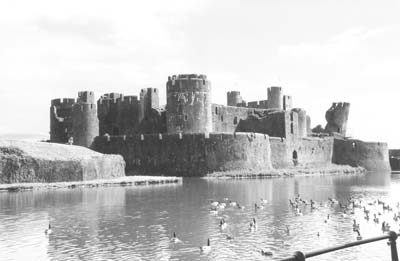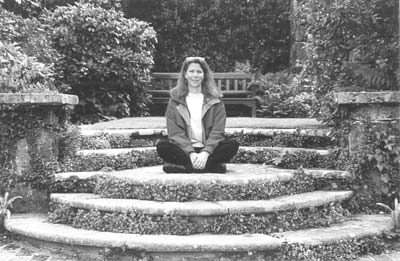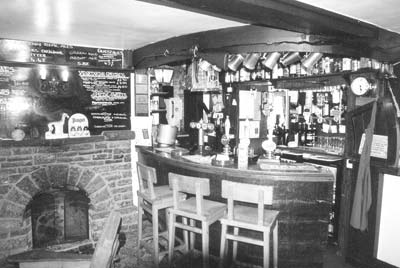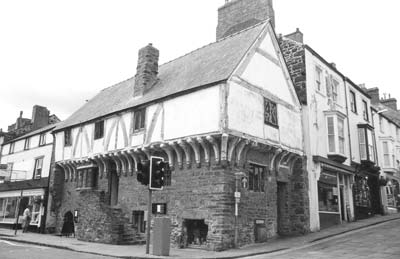Stepping into the past in a land of castles
by Richard and Elizabeth Welch, Annandale, VA
My wife and I have taken several guided trips to various areas of Great Britain hoping to see as much of this very attractive country as possible. While we had obtained good overviews of many of its regions, Wales had been mostly ignored. Although we searched diligently, we had been unable to find any tour company that offered more than a quick passage through this country on the way to or from Ireland. Consequently, we decided to plan our own independent tour.
After some research, we chose our destinations and decided on using three bases for our trip, one in the north, one southwest and one southeast.
In June 2002 we flew from Washington Dulles Airport to London Heathrow, arriving about 8 a.m. We picked up our hire car and departed for northern Wales. Throughout our trip we found traffic to be very light, and none of the venues we visited were particularly crowded.
Portmeirion Our first destination was the Italianate village of Portmeirion. This was to be our home for the first five days and was someplace we had wished to visit for a long time. The village, constructed between 1925 and 1976, was the inspiration of architect Sir Clough Williams-Ellis, who had dreamed since childhood of building a village, as he said, “to my own fancy on my own chosen site.”
Portmeirion, which served as the village featured in the 1960s TV series “The Prisoner,” is a delightful grouping of colorfully painted and exotically designed buildings which accommodate both residences and shops. Not wishing to be in just another hotel, we had secured quarters in one of the several apartments located in the village proper.
Our apartment was part of the Hotel Portmeirion (Gwynedd LL48 6ET; phone 01766 770000, fax 01766 771331 or visit www.portmeirion-village.com). Our room, Cliff House 2, was one of the 26 apartments of various sites located outside of the hotel proper; rates start at £102 (near $160). There are 14 additional rooms in the main hotel.
As residents, we had access to the entire complex after 5 p.m., when the day tourists had to depart. Since the sun did not set until 10 p.m., there were ample opportunities to obtain photos of the many picturesque sites without the presence of large numbers of travelers.
Our accommodations turned out to be altogether comfortable, cozy and convenient. The tariff was £115 (near $180) per night.
The following day was planned to be a full one, so we wished to get an early start. Since breakfast at the hotel did not begin until 8 a.m., we decided to eat at the Little Chef restaurant located just a mile down the road from our hotel.
Restaurants of the Little Chef chain can be found throughout the country. We utilized these restaurants on several occasions, and for what are sometimes small places they all have rather large menus with reasonably good food at budget prices. Meals run £8 to £15 ($12.50-$23.50) for two.
From centuries past
As we enjoy exploring castles, and Wales has around 400, we had chosen what we felt were some of the best. On our first full day out we began with Chirk Castle, which, dating from the 18th century and restored in 1963, has impressive state rooms and extensive, well-maintained gardens.
In the same general area we saw the remains of Valle Crucis Abbey, founded in 1201 by Cistercian monks, and less than 10 miles away near the city of Wrexham is Erddig House, built between 1684 and 1687. Although the exterior of Erddig House is not architecturally impressive, the interior is beautifully furnished with what is said to be one of the finest collections of any country house.
Returning “home,” we had an excellent dinner at the Union Inn (Market Square) in the nearby town of Tremadog.
On Sunday we started our tour in Conwy, a great, walled city to the north with many worthwhile sights. The city wall itself is extensive and well worth the walk, and the great castle is one of the finest survivors in Wales, offering wonderful views from its battlements.
Other sights included Thomas Telford’s elegant suspension bridge, completed in 1826; Aberconwy House, a well-preserved 14th-century timber-framed building, and Plas Mawr, the “finest surviving town house of the Elizabethan era found anywhere in Britain.”
From Conwy we drove southwest some 10 miles to our next three sites, all located within five miles of each other. The first, Penrhyn Castle, is an early 19th-century neo-Norman “castle” home which is beautifully furnished and decorated and has extensive grounds and gardens. Next was Plas Newydd, an 18th-century house famous for its Rex Whistler murals.
Our final stop was a true castle, Beaumaris, on the island of Anglesley. Begun in 1295, it is surrounded by a moat and sits in the middle of the town, making it hard to appreciate its attributes unless seen from an aerial view.
More castle stops
On Monday, on our way to our first stop of the day, we passed through Snowdonia National Park and some of the slate mining country. This provided an opportunity to see how the countryside had been affected by this extensive mining operation.
We soon arrived at Bodnant Garden, situated above the River Conwy and often reported on for its beauty. Unfortunately, it was too late in the year, even in June, for most of the flowering plants. The layout and landscaping were quite attractive, but we were nonetheless disappointed.
From there we moved on to Denbigh, one of Edward I’s castles. It has a mostly intact outer wall, but the inner buildings are largely in ruin. As we were quite close to England at this point, we chose to revisit the city of Chester for a late lunch prior to returning to our home base.
On our last day in the north, we spent the morning in Portmeirion village to visit the numerous shops, closed in the evening. Then we drove to Harlech Castle, one of the most formidable of Edward I’s buildings, which combines great defensive architecture with the natural ruggedness of its setting.
After Harlech we visited Criccieth Castle, where we experienced the only undesirable weather of our trip as it quickly turned windy, rainy and much cooler. With rain gear donned, we made a quick visit of the small castle then drove to Caernarfon Castle, site of the Prince of Wales’ investiture and arguably the greatest of Edward’s castles.
We hoped the rain was not a portent, but on our way the weather cleared and it remained sunny and quite warm for the remainder of our trip.
Diverse properties
The next day, as we drove south, we were able to view more of the lush, green countryside. After a brief stop at Cilgerran Castle, a small ruin near Cardigan Bay, we continued through Fishguard and on to St. Davids, named for the patron saint of Wales. There we saw the wonderfully decorated cathedral (the largest in Wales) and viewed the Bishop’s Palace. The latter is a large ruin, its condition reportedly brought on by a bishop with five daughters who sold the lead cladding from the roof to provide them dowries.
Then it was on to Pembroke Castle, the only castle in Britain to be built over a natural cavern.
We continued north to the small village of Wolfscastle and the Wolfscastle Country Hotel (phone 01437 741225, fax 01437 741383 or visit www.wolfscastle.com), our lodging for the next two nights.
This small hotel was quite comfortable and was well located for our purposes. The room rates were £77 ($120) for bed and breakfast or £107 ($167) including dinner. Breakfast was exceptionally generous with many choices. Dinners were delicious with a wide choice of entrées, including several game dishes. It was an excellent value for the money.
From our base in Wolfscastle, we motored east to Kidwelly Castle, known for its fortifications, and continued west to Llansteffan Castle, located high on a hill overlooking the sea. It was quite a hike up from the parking lot by the sea but well worth it for the views it provided over the countryside.
Next we saw Laugharne Castle and had lunch at the nearby Owl & Pussycat Tea Rooms (located directly across from the castle), where we partook of rather delicious Welsh Rabbit. The total for lunch for the two of us was a reasonable £15.
Following lunch we drove to the small town of Tenby to see the Tudor Merchant’s House, one of the first Welsh properties to be acquired by the National Trust. St. Mary’s parish church was also worth a quick visit.
The road to Cardiff
Friday, we repacked our suitcases and made our way toward Cardiff. Our first stop, Castle Coch (the Red Castle), just north of Cardiff, was the summer home of the third marquess of Bute, who was reputedly the richest man in the world at one time.
The small castle, now a Victorian fantasy, was built on the ruins of a 13th-century fortress. Little more than the lower walls remained when reconstruction began in 1875. The castle was completely reconstructed and decorated as the architect imagined it would have looked when new. Although small, it is romantic and truly spectacular.
The next site was Caerphilly, an enormous, 13th-century castle with complex land and water defenses covering over 30 acres. It is set in the midst of a large lake, which makes it picturesque today and extremely difficult to have assaulted in the past. An identifying facet of Caerphilly is its severely leaning tower, which echoes that of Pisa. Located conveniently across the road from the castle is a nice restaurant called Glamours, which offers a variety of lunches for £10-£20.
Cardiff
From Caerphilly it was a short drive south to Cardiff, the Welsh capital. There are several points of interest in this attractive city. Among these are the intricately decorated Pierhead Building, built in 1896 for the Cardiff Railway Company; the neoclassical civic buildings, and the Royal Arcade, a covered market dating from 1856.
Our prime interest in Cardiff was the castle, also restored by the third marquess of Bute. Its restoration was not designed to provide historical accuracy but rather to satisfy the dreams of its owner. As such, it is a splendid Victorian period piece with lavishly decorated rooms reflecting the Victorian ideas of medieval romance. There are murals, painted decorations, carved wood embellishments, stained-glass windows, marquetry inlays and many other eye-catching sights throughout the castle.
Toward the end of the day it was time to find our next accommodation. We had chosen the Greyhound Inn (phone 01291 672505, fax 01291 673255 or visit www.greyhound-inn.com) located near the village of Llantrisant some 20 miles northeast of Cardiff and well off the beaten path.
When we arrived, we found the inn proper to consist of several attached rooms on different levels, all of which dated from the 17th century. There were open beams, thick walls, low overheads and much charm. The bedrooms themselves were located in a separate building specially constructed in 1988 and were consequently modern, cozy and appealing.
As we were in the countryside, we planned to take dinner at the hotel, but upon inquiry we were told the restaurant was fully booked. As we expressed our dismay, we were informed that we could eat in the bar, which would serve the same menu. Exploring, we found the dining room was actually two separate rooms, and there were three separate bars plus perhaps a dozen tables located outside — rather quite a lot, we thought, for a small country inn. As the evening wore on, however, all of these spaces became filled with dinner guests.
We found our meals to be superb, and obviously the locals had made this same discovery as the inn was doing a land-office business at dinnertime. The three bars all were decorated differently and were fascinating. We liked the ambiance so much that we chose to eat in the bar on the following evening. And, yes, the inn was again packed with diners.
Meals were quite reasonable, and we paid £25-£30 ($39-$47) for two with soft drinks and dessert. The room rate at the Greyhound was £57 ($89) per night with breakfast (also delicious and ample).
Fortifications to explore
On Saturday we made our first stop Tintern Abbey. Founded in 1131 and rebuilt in the late 13th century, this reportedly is the best-preserved medieval abbey in Wales and is featured in many pictures and postcards. We had the location largely to ourselves to explore as we were wont.
After this quiet interlude, we turned south to Chepstow Castle, a large fortification located near the mouth of the river Wye, then back north to Raglan Castle, which appeared much older than its 15th-century origins.
As we were in Wales, the land of castles, and time was available, we added the Three Castles, small fortifications in the north of the Wye Valley: Grosmont, Skenfrith and White. These paled in comparison to the great castles we had already visited but sufficed to show how various types of fortifications/living accommodations served the populace of the time.
An in-depth look
Our planned itinerary of Wales completed, we were up early the following morning in order to beat any traffic on our way back to Heathrow to catch our flight to the U.S.
Obviously, no one can cover any country, or even a region, in just one trip. However, we felt we had accomplished all that we had set out to do and had given ourselves a reasonably good, in-depth look at Wales. It is a beautiful country with such friendly people that another trip is high on our list of things to do.
It is well to note that many of the properties we visited were under the care of either the National Trust (www.nationaltrust.org.uk) or CADW (Welsh Historic Monuments; visit www.cadw.wales.gov.uk). A membership in either of these organizations or the purchase of a Great British Heritage Pass provides free admission to all their properties — a great savings over paying for each entry separately.






